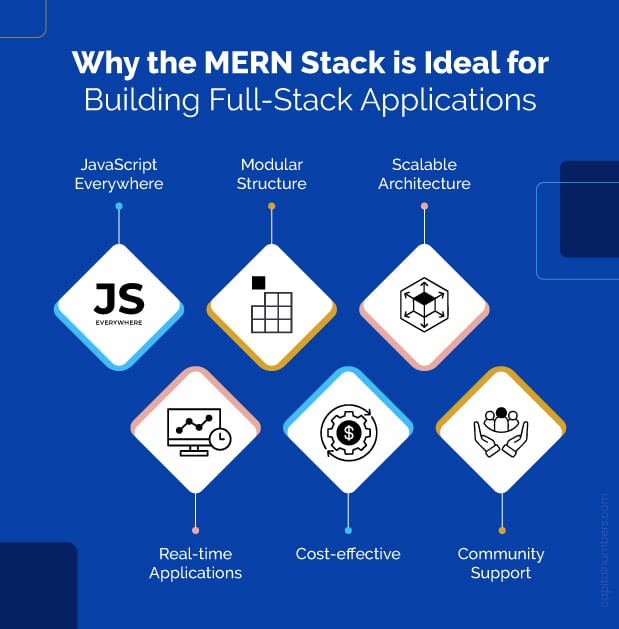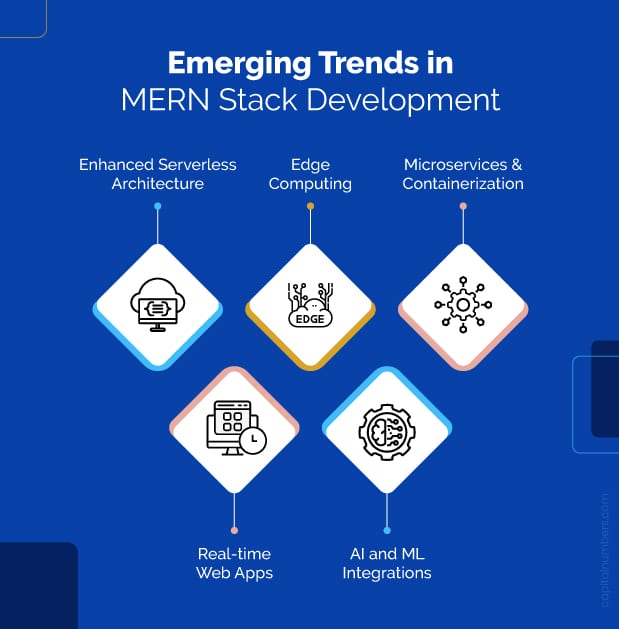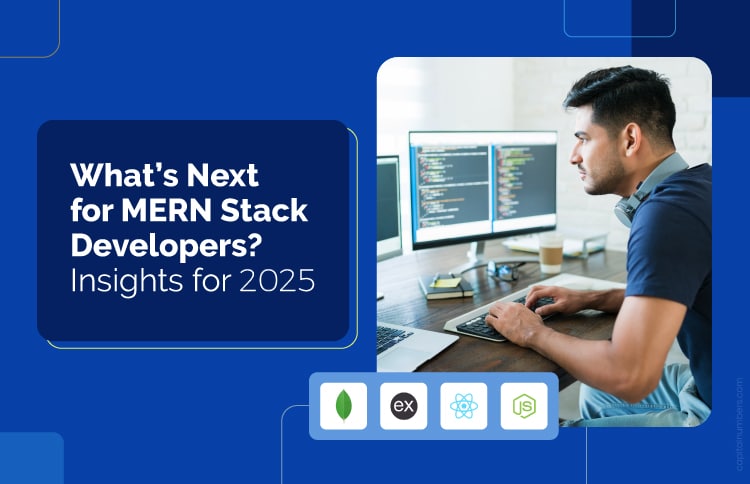What’s Next for MERN Stack Developers? Insights for 2025
Table of Contents
The MERN stack – MongoDB, Express.js, React, and Node.js – is one of the most popular technology stacks for web development today. It enables developers to build dynamic, full-stack applications using JavaScript from the frontend to the backend. Each component plays a critical role:
- MongoDB: A NoSQL database that stores data in a flexible, JSON-like format.
- Express.js: A minimal and fast web framework for building APIs and server-side logic.
- React: A powerful library for creating user interfaces with a component-based architecture.
- Node.js: A runtime environment that allows JavaScript to run on the server, making it possible to use a single language across the entire application stack.
MERN stack developers use these technologies to build strong and scalable applications. It’s a great choice for startups and small businesses and is also widely used for enterprise application development.
State of the MERN Stack in 2024
Over the years, the MERN stack has found its place in various industries due to its adaptability. Here’s how different sectors are leveraging it:
- E-commerce: Platforms like Shopify and custom-built e-commerce websites use the MERN stack to create fast, scalable, and user-friendly experiences. React ensures smooth interfaces, while Node.js handles high-traffic backend operations.
- SaaS (Software as a Service): SaaS platforms prefer MERN for its component-based frontend (React) and RESTful API support (Express + Node.js). Its versatility makes it suitable for subscription models, data dashboards, and user management systems.
- Fintech: Security, speed, and scalability are essential in fintech app development. MERN fits well here, with MongoDB providing secure data storage and React enabling intuitive interfaces for banking, trading, and financial planning apps.
- Education and LMS: Learning Management Systems (LMS) benefit from the stack’s ability to handle multimedia content, real-time data sharing, and user management.
These industries and others, like healthcare, travel, and social media, are continually adopting the MERN stack for its ability to deliver reliable, feature-rich applications.
Why the MERN Stack is Ideal for Building Full-Stack Applications

The MERN stack shines as a robust and developer-friendly solution for building full-stack applications. Here’s why:
- JavaScript Everywhere: Developers can use a single language (JavaScript) across the frontend, backend, and database queries, simplifying the development process.
- Rapid Development: The modular structure allows MERN stack developers to reuse components, accelerate development, and reduce redundancies.
- Scalable Architecture: MongoDB’s schema-less nature and Node.js’s asynchronous processing make it easier to build scalable apps.
- Community Support: Each technology in the stack has a strong and active developer community, providing plenty of resources, libraries, and tools to speed up the development process.
- Real-Time Applications: MERN is ideal for real-time apps like chat applications and collaborative tools, thanks to Node.js’s support for WebSockets.
- Cost-Effective: Open-source technologies in the MERN stack reduce licensing costs, making it an affordable choice for startups and small businesses.
Challenges Developers Face with MERN in 2024
While the MERN stack offers numerous advantages, developers face some challenges, especially as applications scale and user demands grow:
- Scaling Applications:
- Challenge: Scaling backend services for applications handling millions of users can be complex. MongoDB, while flexible, may face performance bottlenecks with poorly optimized queries.
- Solution: MERN stack developers increasingly use database sharding, caching (e.g., Redis), and horizontal scaling techniques.
- Real-Time Data Handling:
- Challenge: Managing real-time features like notifications, chat, or live dashboards can be challenging with high concurrency.
- Solution: Tools like Socket.IO for WebSockets and Redis for message queuing are becoming essential.
- Performance Optimization:
- Challenge: React’s re-renders and MongoDB’s large data queries can impact app performance if not optimized.
- Solution: Techniques like memoization in React, indexing in MongoDB, and using tools like React Profiler and APMs (Application Performance Monitoring) are gaining traction.
- Complexity in Large Applications:
- Challenge: As applications grow, maintaining code becomes harder, especially when managing state across multiple components.
- Solution: Developers are increasingly using advanced state management tools like Redux Toolkit or Context API, and modularizing code for easier maintainability.
- Security Concerns:
- Challenge: Handling sensitive data, such as payment details in fintech or healthcare, requires airtight security measures.
- Solution: Developers are adopting best practices like encrypting data, using Helmet.js for securing HTTP headers, and validating inputs thoroughly.
In 2024, the MERN stack remains a strong choice, but developers must address these challenges head-on to unlock its full potential. As we move toward 2025, the stack is set to evolve, offering new tools and practices to help developers build better, faster, and more scalable applications.
Emerging Trends in MERN Stack Development

The MERN stack is evolving rapidly, and several trends are shaping its future in 2025.
a. Enhanced Serverless Architecture Adoption
The shift from traditional hosting to serverless platforms like AWS Lambda and Google Cloud Functions is transforming how MERN stack applications are deployed.
- What is Serverless?
Serverless architecture allows developers to focus on writing code without worrying about managing servers. Resources are automatically allocated based on demand, reducing costs and improving scalability. - MERN and Serverless
MERN applications can integrate seamlessly with serverless services:- The backend (Node.js + Express) can be deployed as serverless functions.
- MongoDB Atlas works well with serverless setups for database management.
- React frontends hosted on platforms like AWS S3 integrate effortlessly.
b. The Rise of Edge Computing
With edge computing, MERN applications can process data closer to the user rather than relying solely on centralized servers.
- What is Edge Computing? Edge computing uses distributed data centers and Content Delivery Networks (CDNs) to handle user requests locally, improving speed and reducing latency.
- MERN in Edge Computing
- React frontends can be hosted on platforms like Vercel or Cloudflare Workers, which leverage edge servers.
- Node.js APIs can be distributed for faster response times.
- Benefits
- Faster load times for users.
- Better performance for real-time applications, like gaming or live video streaming.
c. Microservices and Containerization
Breaking down monolithic MERN apps into smaller, independent microservices improves flexibility and scalability.
- Microservices in MERN
Instead of a single large app, developers can divide a MERN app into smaller services:- User authentication as one service.
- Payment processing as another.
- Each microservice runs independently but works together.
- Containerization with Docker and Kubernetes
- Docker: Packages each service with its dependencies, ensuring it runs consistently across environments.
- Kubernetes: Manages and scales these services automatically.
- MongoDB in MicroservicesMongoDB can be used in a distributed database setup, allowing each service to manage its data independently.
d. Real-Time Web Apps with MERN
Real-time functionality is becoming a critical part of modern applications, and MERN is well-suited for these use cases.
-
- Using WebSockets with Socket.IO
Node.js and Socket.IO enable real-time data transfer between the server and the client. This is perfect for:- Collaborative tools: Real-time document editing or project management apps.
- Live dashboards: Data visualization that updates dynamically.
- Chat apps: Instant messaging.
- Using WebSockets with Socket.IO
Challenges and Solutions
-
- Concurrency: Managing thousands of simultaneous connections.
- Scaling: Using Redis for message queuing and clustering Node.js servers to handle high loads.
e. AI and Machine Learning Integrations
The MERN stack is becoming a strong foundation for AI and machine learning development services.
- How AI Fits with MERN
- Use TensorFlow.js or Brain.js to build machine learning models in JavaScript.
- Integrate AI-powered features, such as recommendation engines or chatbots, into React-based frontends
- MongoDB for AI Data
MongoDB’s ability to handle unstructured and large datasets makes it ideal for managing data used in AI models.
Hire Expert MERN Stack Developers to build scalable, efficient, and modern applications tailored to your needs. Contact us today to bring your ideas to life!
Key Technology Upgrades to Watch in MERN Stack Development for 2025
As we approach 2025, several technological upgrades are shaping the future of MERN stack development. These advancements across MongoDB, React, Node.js, and DevOps tools are helping MERN stack developers build more efficient, scalable, and high-performing applications.
a. MongoDB Enhancements
- MongoDB 7.0 Features
The upcoming version brings performance improvements and better support for handling large-scale data. Developers can expect faster operations and more efficient memory usage, making it ideal for enterprise-grade applications. - Native AI and Cloud Integration
MongoDB is moving toward seamless integration with AI tools and cloud platforms. This makes it easier to store and retrieve AI-related data, such as training datasets, and to scale applications on cloud environments like AWS, Azure, or Google Cloud. - Improved Indexing and Querying
MongoDB’s indexing capabilities are being refined to handle complex queries faster. This is particularly useful for applications with large datasets, like e-commerce platforms or data analytics dashboards.
b. React Framework Advancements
- React Server Components (RSC)
RSC allows developers to render components on the server, reducing the amount of JavaScript needed on the client side. This leads to faster page loads and better performance, especially for content-heavy applications. - React 18+ Features
React’s latest updates focus on:- Concurrent Rendering: Enables React to prioritize updates, improving user experience during high-interaction scenarios.
- Automatic Batching: Groups state updates to reduce unnecessary renders, boosting performance.
- Trends in State Management
While Redux remains a staple, lightweight alternatives like Zustand and newer tools from Redux Toolkit are gaining traction. These options simplify state management for small to medium-sized applications without the overhead of traditional Redux setups.
c. Node.js Evolution
- HTTP/3 and QUIC Adoption
HTTP/3, powered by QUIC, improves web performance with faster connections and reduced latency. This is particularly beneficial for real-time applications and APIs running on Node.js. - Node.js 22+ Performance Upgrades
Recent updates focus on optimizing memory usage, reducing startup times, and enhancing overall application speed, making Node.js an even more reliable choice for backend development. - Enhanced Multi-Threading
Features like Worker Threads and WebAssembly support enable better handling of computationally heavy tasks. This allows Node.js to handle parallel processing efficiently, improving scalability for applications with complex backend logic.
d. DevOps and CI/CD Tools for MERN
With the increasing complexity of modern applications, DevOps tools and practices are playing a bigger role in MERN stack development.
- Advanced DevOps Pipelines
Developers are creating more sophisticated CI/CD pipelines to automate testing, deployment, and monitoring for MERN apps. These pipelines ensure faster, error-free deployments. - Automation Tools
Tools like GitHub Actions and Jenkins are streamlining workflows by automating repetitive tasks, such as code integration, unit testing, and application builds. - Cloud-Native Deployments
Technologies like Terraform and Pulumi simplify infrastructure management for cloud-native applications. They allow developers to define infrastructure as code, ensuring consistency and scalability for MERN deployments on platforms like AWS and Azure.
You May Also Read: DevOps Automation Best Practices: Tips for Success
The Future of MERN in Web Development
The MERN stack remains a popular choice for full-stack development, but with the constant advancements in web development, it faces new competitors and exciting opportunities. Let’s explore what the future might hold for MERN in web development.
Potential Competitors
While the MERN stack remains a strong contender, several other stacks and frameworks are emerging, offering unique approaches to building web applications:
- JAMstack (JavaScript, APIs, and Markup):
JAMstack emphasizes speed and simplicity by pre-rendering static sites and using APIs for dynamic functionality. It’s a strong competitor for developers focused on performance and SEO, particularly for content-heavy websites like blogs or portfolios. - MEVN Stack (MongoDB, Express.js, Vue.js, Node.js):
Similar to MERN, but with Vue.js replacing React. Vue is known for its simpler learning curve and flexibility, making MEVN an appealing choice for developers who prefer Vue’s approach to building user interfaces. - T3 Stack (Next.js, TypeScript, Tailwind CSS, tRPC):
The T3 stack is gaining popularity for its focus on developer experience and modern technologies. It integrates TypeScript and focuses on building scalable, type-safe applications, making it an alternative for MERN developers looking to adopt newer trends.
While these competitors bring fresh ideas, MERN’s versatility and widespread adoption ensure it will remain a key player in the web development space.
MERN’s Role in Supporting Decentralized Applications (dApps)
As blockchain technology and decentralized applications (dApps) grow, MERN has a unique role to play:
- What Are dApps?
Decentralized applications run on blockchain networks, offering transparency and eliminating the need for centralized servers. - How MERN Fits
- React: Perfect for building user-friendly interfaces for interacting with blockchain-based services.
- Node.js + Express: Ideal for creating APIs that communicate with blockchain smart contracts.
- MongoDB: Useful for off-chain storage of data that doesn’t need to be stored directly on the blockchain.
- Future Possibilities
MERN developers can integrate their stack with blockchain frameworks like Ethereum or Polygon, enabling the creation of decentralized marketplaces, finance platforms, and more.
Predictions on How AI Will Redefine Development Workflows
Artificial Intelligence (AI) is set to transform how developers work, and MERN will be no exception:
- AI-Assisted Coding:
Tools like GitHub Copilot and TabNine are already helping developers write code faster. By 2025, AI is expected to become even more integrated, suggesting solutions, optimizing performance, and even automating repetitive tasks in MERN applications. - AI-Powered Features in MERN Apps:
Developers will increasingly integrate AI capabilities, such as:- Personalized recommendations for e-commerce platforms.
- Predictive analytics for SaaS dashboards.
- Natural language processing (NLP) for chatbots and virtual assistants.
- Streamlined Development Workflows:
- AI can analyze codebases to identify bugs or suggest best practices.
- It can automate testing, ensuring higher code quality with less manual effort.
By adopting AI, MERN developers will be able to focus on creative problem-solving while letting AI handle repetitive or time-consuming tasks.
Download Our E-book: Optimizing Node.js Performance: A Comprehensive Guide to Building Faster Applications
Conclusion
The MERN stack offers exciting opportunities for developers to build scalable, efficient, and modern applications. However, it also comes with challenges like handling scalability, integrating advanced tools, and competing with emerging technologies. By staying updated and learning new trends like serverless architectures, AI integrations, and microservices, MERN stack developers can overcome these challenges and create innovative solutions.
As the web development field evolves, adapting and embracing new practices is key to staying ahead. Despite growing competition, the MERN stack remains a powerful and versatile choice for building full-stack applications, ensuring its relevance for years to come. Developers who continue to innovate and refine their skills with MERN will be well-prepared to tackle future demands and opportunities.















